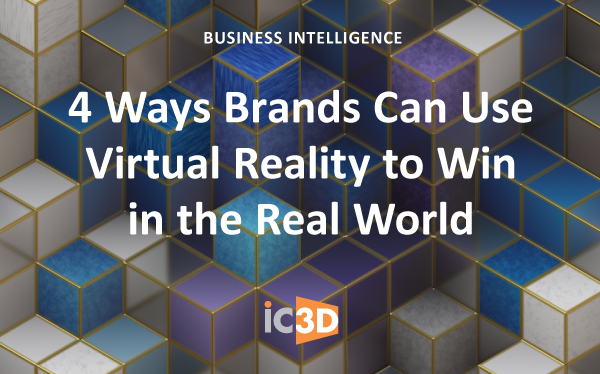Virtual Reality (or VR) is all around us. For decades, brand marketers have been using enhanced digital images, videos, animations, and voiceovers. They do it to persuade us to buy their products and keep buying them. VR persuades because it seems real—from the sexy model to the cool car doing amazing things. (“Dramatization. Do not attempt,” says the small print.)
VR is also increasingly used in the world of computerized 3D models. This is not just games or entertainment, but in the everyday world of products and services. You can take a virtual tour of a condo, test drive a virtual car, or display a virtual product in an online store. It sounds like the distant future, along with flying cars and hover boards. The reality is far closer—especially for brand managers.
The Whole Package
A brand product is usually identified with its physical package. Coke and Pepsi are not identified with fizzy brown liquids, but with their distinctive bottles (and the sexy people holding them.) Actual cans and bottles can be photographed or filmed, but you can get greater creative impact—and lower cost—with computer models.
What once took weeks of programming and rendering now takes minutes. Photorealism is improving on a daily basis. It’s only a matter of time before VR for 3D objects is as common as color retouching a car or a fashion model.
Brand managers may have a few years before VR affects their advertising. But the technology is available now for other, critical tasks. Here are three ways brands can use VR and three-dimensional models to increase the chances of success in the real world.
1. Alter Time
We’re not talking about time travel. Package design is a notoriously complex, time-intensive process. For consumer products, a package must be:
- Functional (It has to hold all the contents.)
- Efficient (It has to facilitate shipment, display, and consumer convenience.)
- Legal (It must important information and disclaimers.)
- Attractive and recognizable (It must attract a shopper’s attention within a very narrow decision window—2.6 seconds according to one study.)
This means many decisions by many people. Conventional packaging design, prototyping, and production is a weeks-long process. By using digital simulations, that time is reduced dramatically. All the “what if” discussions can take place immediately, a brand company can reduce the total time to market by as much as 85%.
2. Speed Up Marketing Decisions
For consumer product companies, placement is everything. With so many competing products on a shelf, brand managers must see how a particular design looks in context. In the past, that meant field research and focus groups.
With a good 3D model, many of those decisions can be made virtually. A VR simulation can place the latest design on a shelf—alongside the competition. Even in-store lighting conditions can be simulated, letting decision makers consider multiple “what if” scenarios.
3. Avoid Production Glitches
Unlike regular printing, packaging uses materials that have unique properties, like the way shrink wrap distorts when surrounding multiple items. In the packaging world, this a constant source of unpleasant surprises.
Good 3D virtual models are created with these properties in mind. They will anticipate such behaviors, and compensate for them. Not every 3D system can do this, of course, but the well-engineered ones do.
4. Look to the Future
The VR approach is a winning strategy for making package design and production vastly more efficient. It won’t stop there.
As brand marketers become used to the advantages of products like iC3D in their day-to-day design decisions, they will surely look to other ways of making 3D models part of their messaging and promotion efforts.
Watch this (virtual) space!






